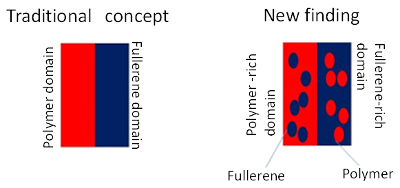Intermixing Molecules are Key to Energy Conversion Efficiency in Solar Cells
Nanostructure of organic solar cell materials revealed
2014.04.17
(2014.06.16 Update)
University of Tsukuba
National Institute for Materials Science (NIMS)
High Energy Accelerator Research Organization (KEK)
Hiroshima University
National Institute of Advanced Industrial Science and Technology (AIST)
The research group consisting of Yutaka Moritomo, professor, and Takeaki Sakurai, associate professor, Department of Pure and Applied Sciences, University of Tsukuba; Takeshi Yasuda, senior researcher, Organic Thin-Film Solar Cells Group, NIMS; Kanta Ono and Kazuhiko Mase, associate professors, and Yasuo Takeichi, assistant professor, Institute of Materials Structure Science, KEK; Yoshio Takahashi, professor, Graduate School of Science, Hiroshima University; and Yuji Yoshida, senior researcher, Research Center for Photovoltaic Technologies, AIST, examined the nanostructure of organic solar cells using a soft X-ray microscope and discovered that different molecules are intermixed in each molecular domain.
Abstract
The research group consisting of Yutaka Moritomo, professor, and Takeaki Sakurai, associate professor, Department of Pure and Applied Sciences, University of Tsukuba; Takeshi Yasuda, senior researcher, Organic Thin-Film Solar Cells Group, NIMS; Kanta Ono and Kazuhiko Mase, associate professors, and Yasuo Takeichi, assistant professor, Institute of Materials Structure Science, KEK; Yoshio Takahashi, professor, Graduate School of Science, Hiroshima University; and Yuji Yoshida, senior researcher, Research Center for Photovoltaic Technologies, AIST, examined the nanostructure of organic solar cells using a soft X-ray microscope and discovered that different molecules are intermixed in each molecular domain. This discovery is expected to reveal the energy conversion mechanism in organic solar cells and thereby facilitate the establishment of guidelines to design high efficiency organic solar cells.
Bulk heterojunction organic solar cells are characterized by their high energy conversion efficiency. In order to improve the efficiency of cells, it had been thought to be important up until now to have a clean interface between a polymer material and a single molecular domain of a fullerene. However, when we carefully examined the domain structure of cell materials that were optimized for energy conversion efficiency using a new methodology involving a soft X-ray microscope, we found that different molecules were intermixed in each molecular domain. In other words, we found that cells with a “dirty” interface have superior performance to those with a “clean” interface. This new discovery defies the common understanding of the energy conversion mechanism.
These study results will be published on April 16 in the online version of Applied Physics Express, a journal issued by the Japan Society of Applied Physics.

Figure 1 in the press release. The interface state as conventionally understood (left) and the interface structure in which we observed intermixed molecules in this study (right)
